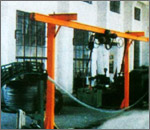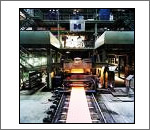Introduction: Direct strip casting is a continuous casting process for producing metallic sheets directly from the molten metal without undergoing any intermediary process. This mo

dern technique reduces the requirement for further secondary process like rolling and reheating. This process is being widely used now as day to cast steel strips.
Direct strip casting technology can be used for a range of alloys, including carbon and stainless steel, aluminum, magnesium, titanium, copper and other non-ferrous alloys. An up-coming casting process this process is highly useful in manufacturing near-net-shape castings.
Process: In direct strip casting, hot metal in transported for sol using a dispenser system. The molten metal is fed from a supply system on which the metal flows constantly. The molten metal is fed on an intensively cooled revolver belt. The belts is cooled by the water that comes from a cooling chamber. The solidification and the the cooling process takes place is an extremely protected atmosphere which helps in preventing oxidation, reduces material loss and helps is casting quality products.
On solidification, the metal sheet is hot rolled, without again reheating its. The solidified strip is moved to the roller table by the moving belt. The belt moves by the the synchronized rotation of two rolls. Strip thicknesses is checked by controlling the flow of the metal and by adjusting the speed of the belt. Using direct strip casting method steel strips less than 2mm thick can be casted. The main factors that control the casting process is the solidification and the cooling factors.
 Application:
Application: Direct strip casting is highly useful for manufacturing near-net-shape castings out of steel, carbon and stainless steel, aluminum, magnesium, titanium, copper and other non-ferrous alloys.
Advantage:
- Strips as thin as 2mm can be casted
- Cost effective technique that reduces need for rolling passes
- Opened the way for more fine-grained and higher-strength steels and alloys.


